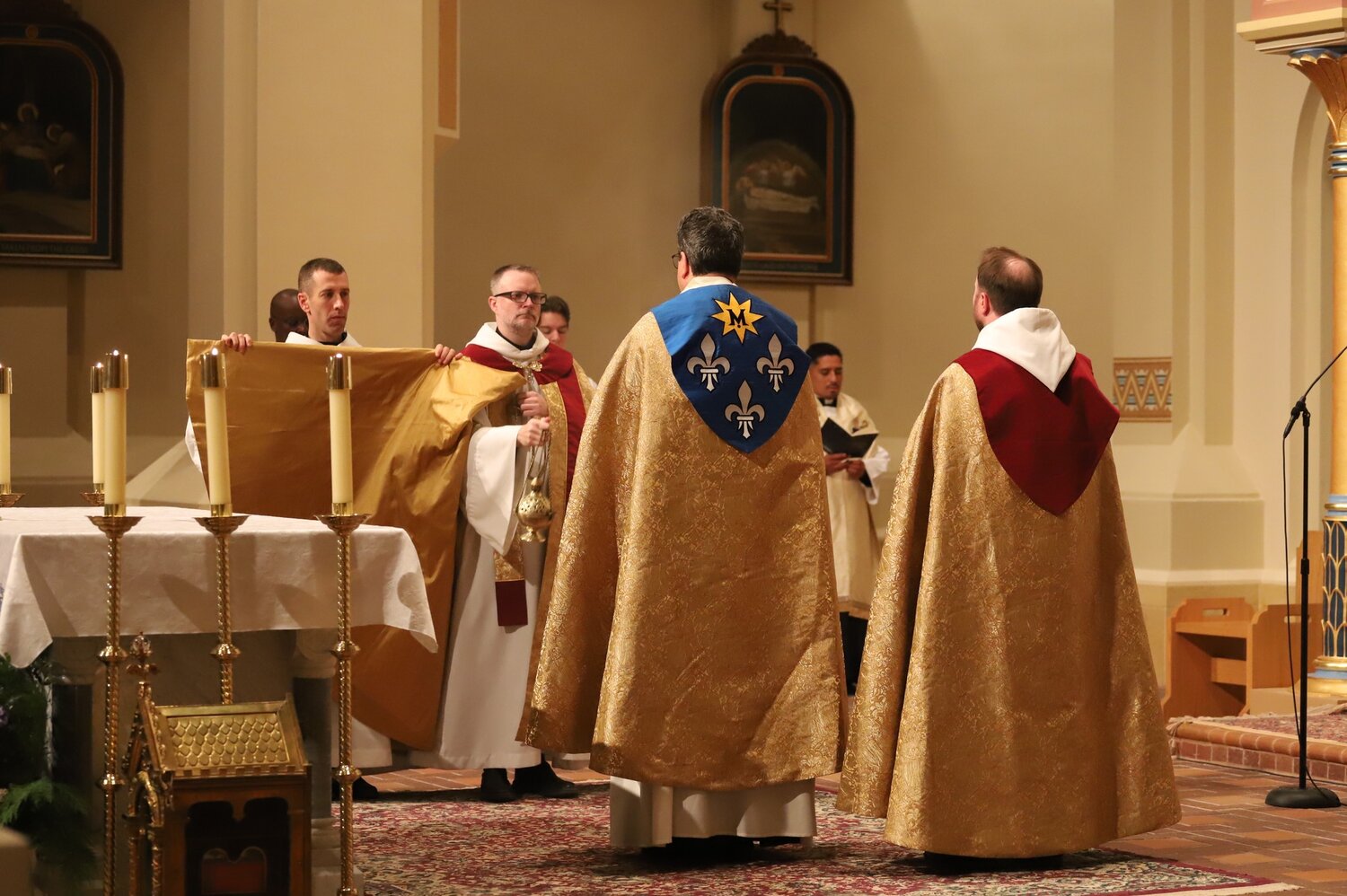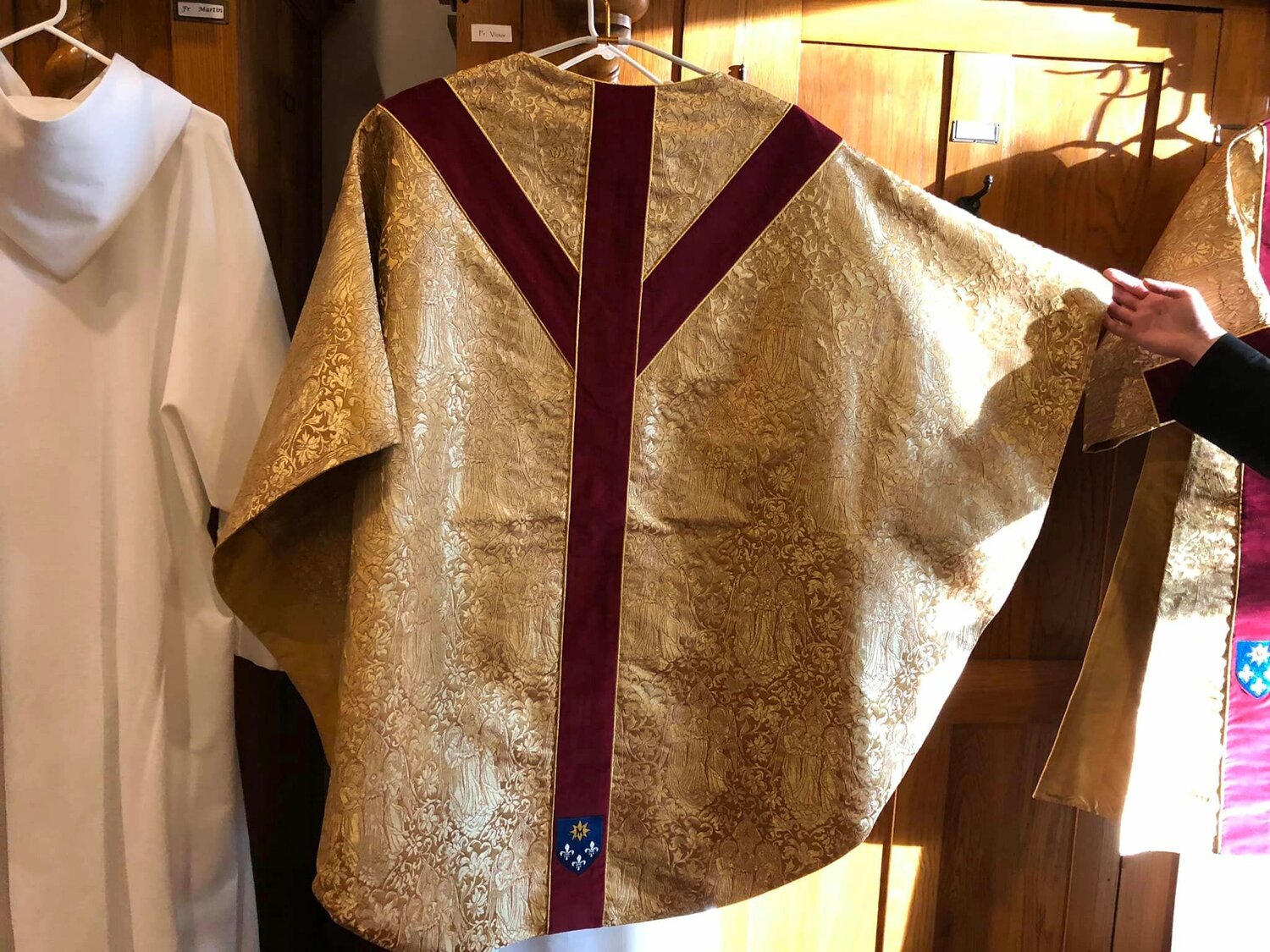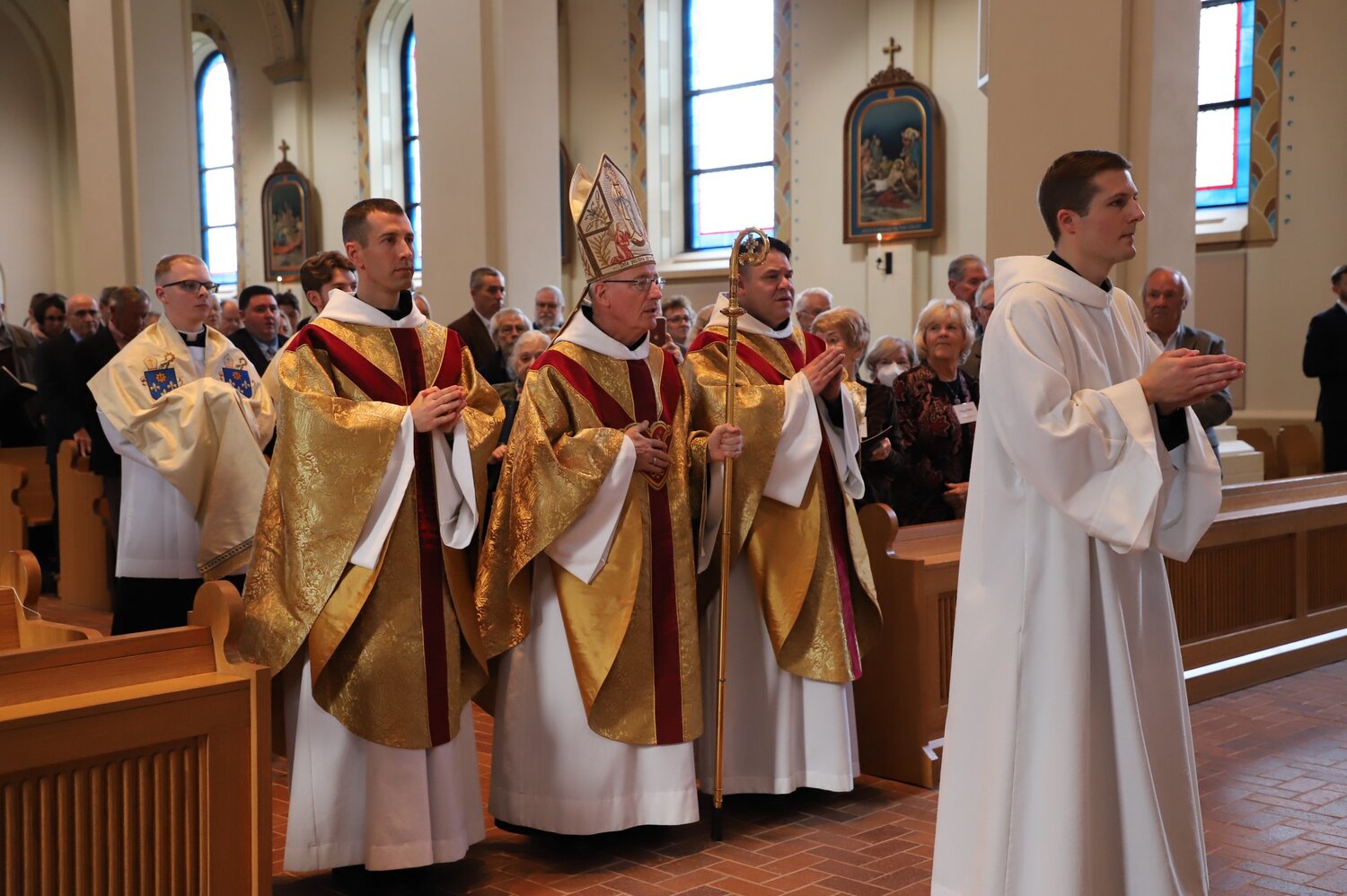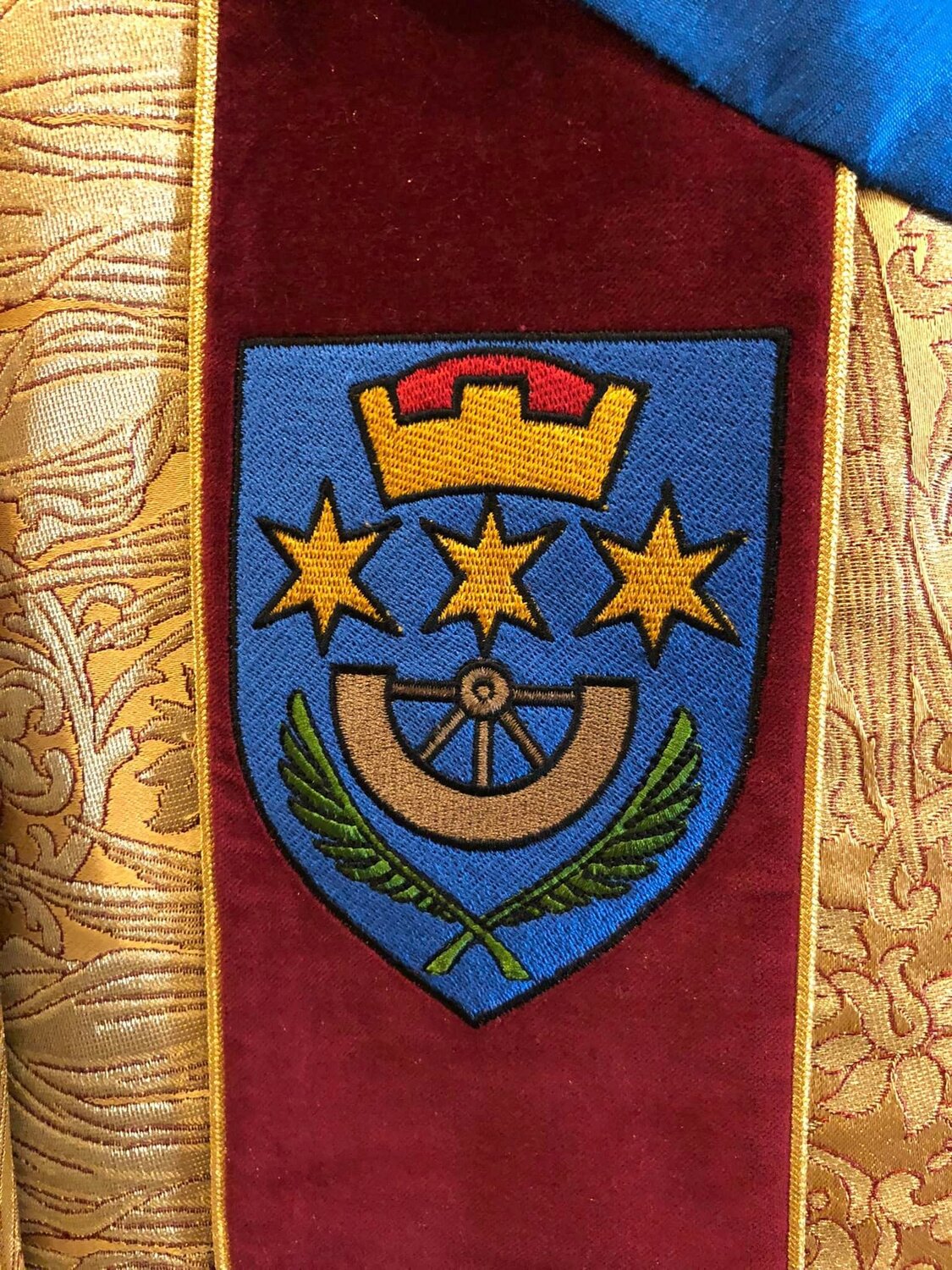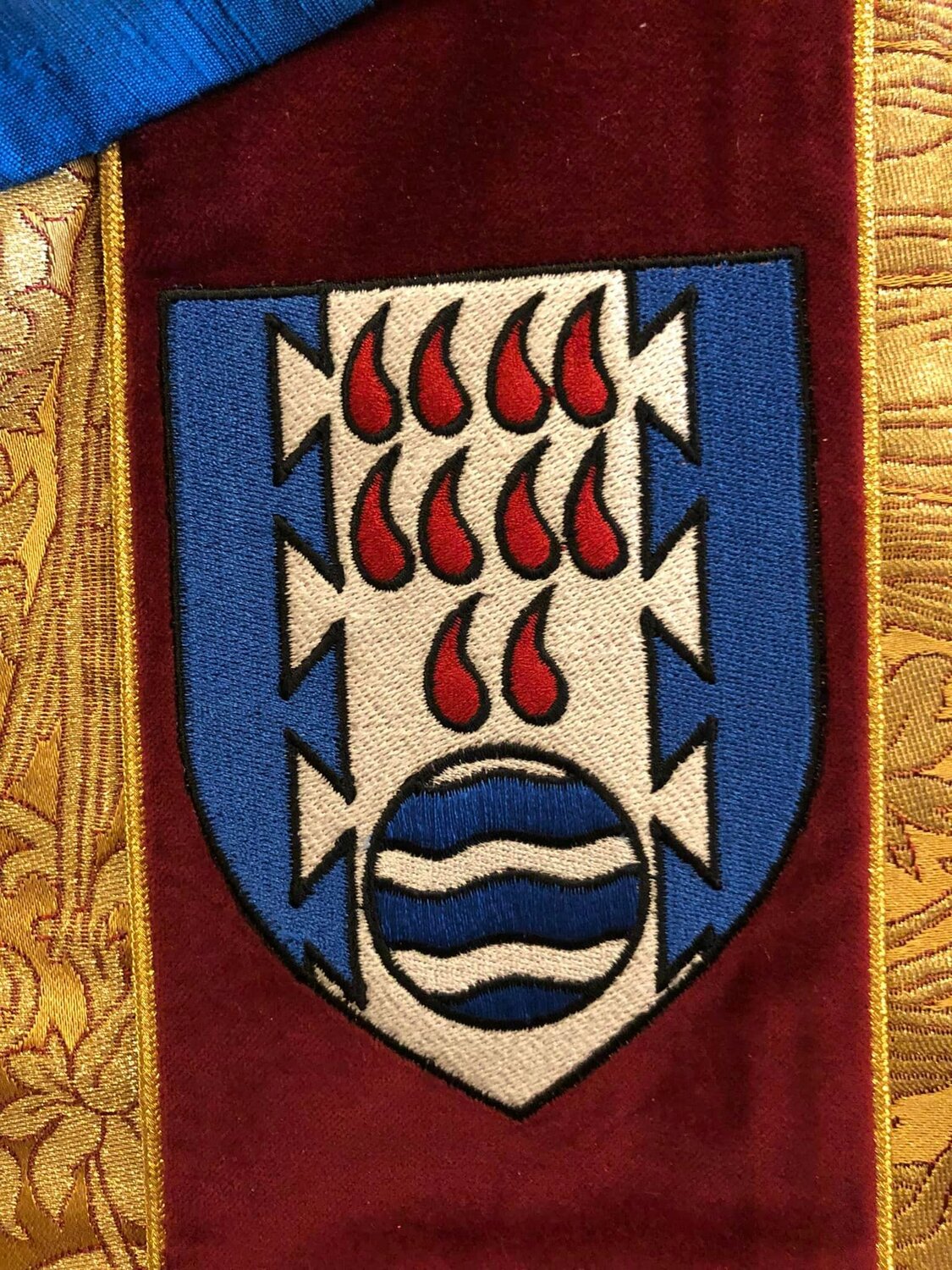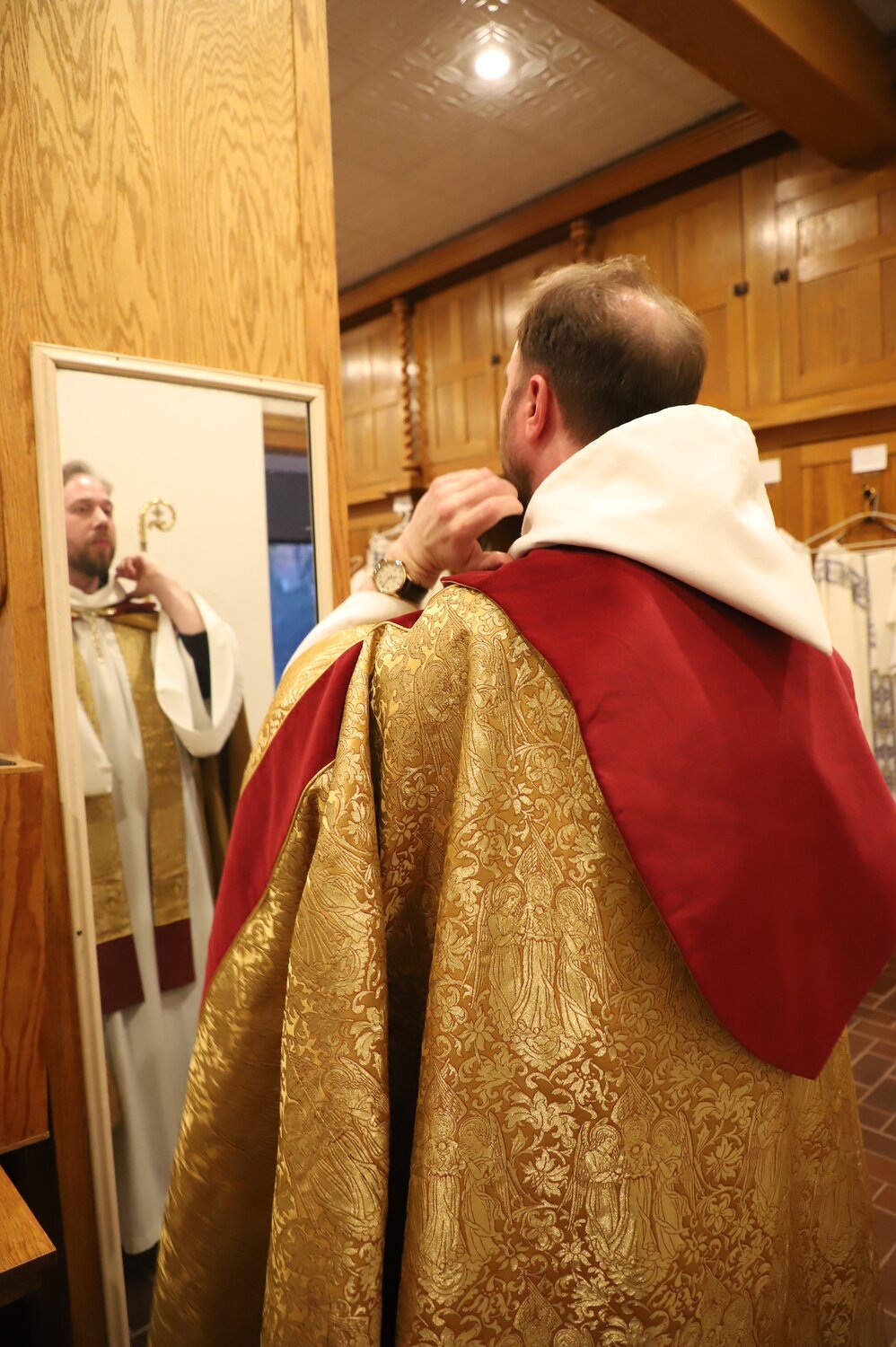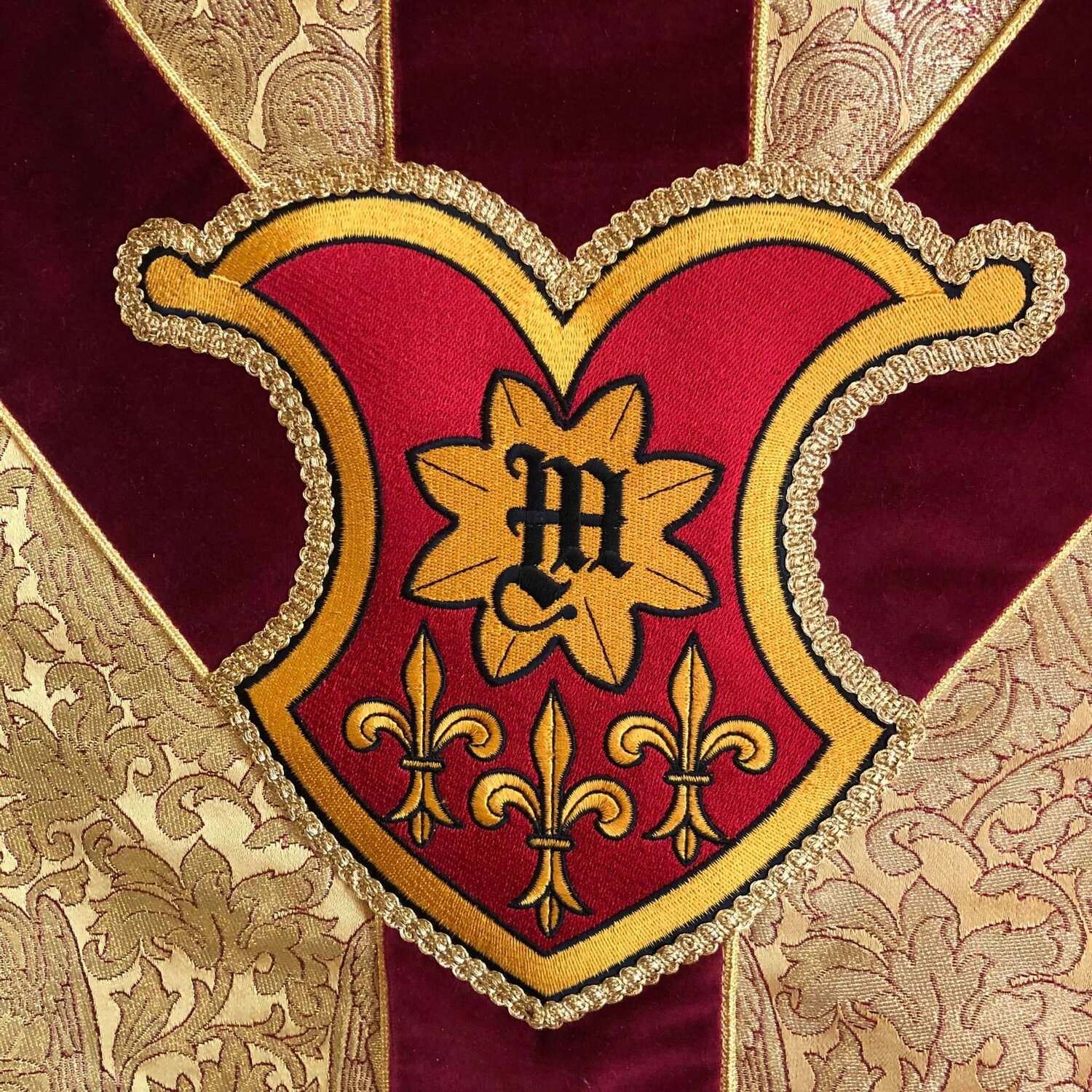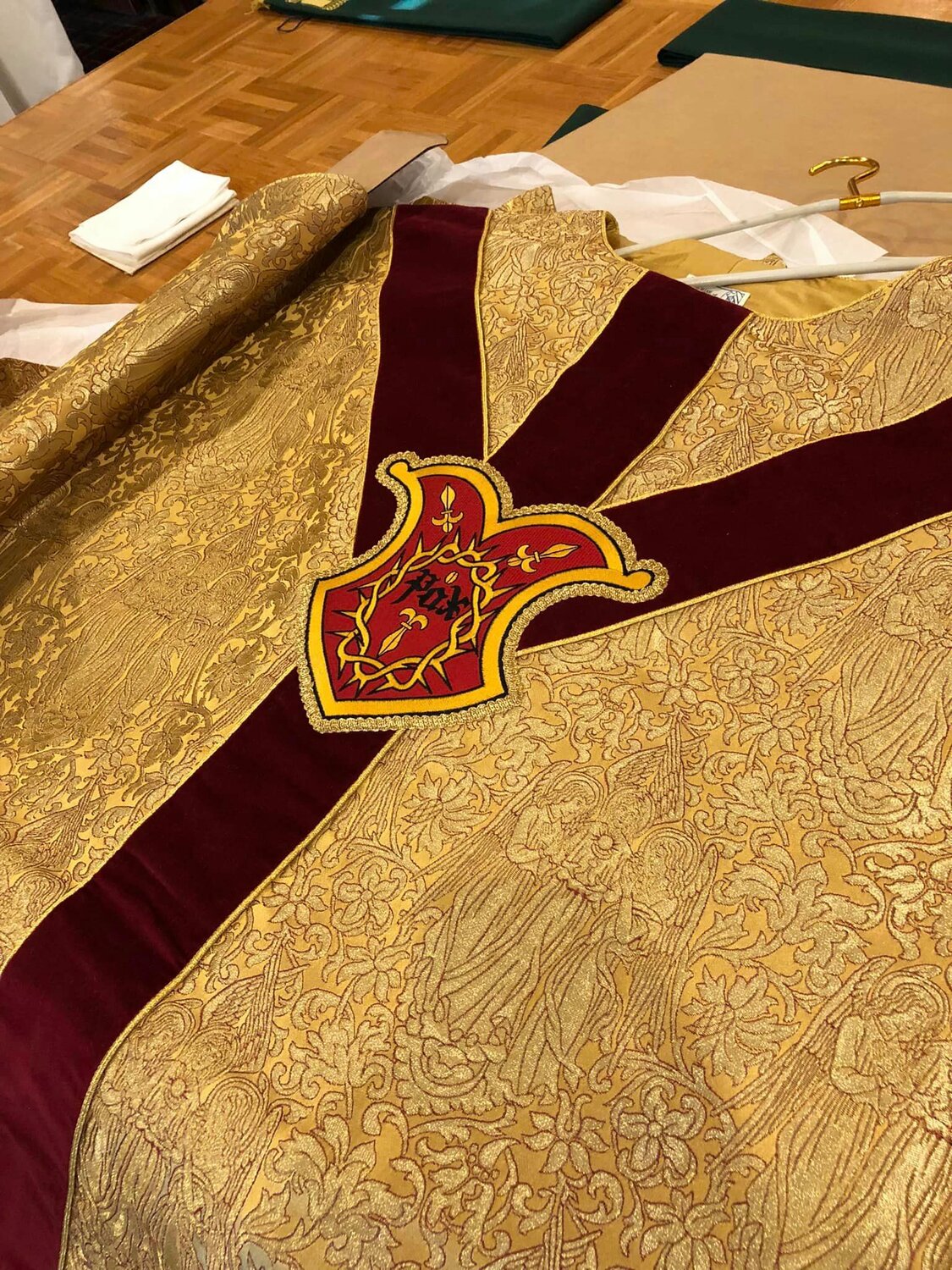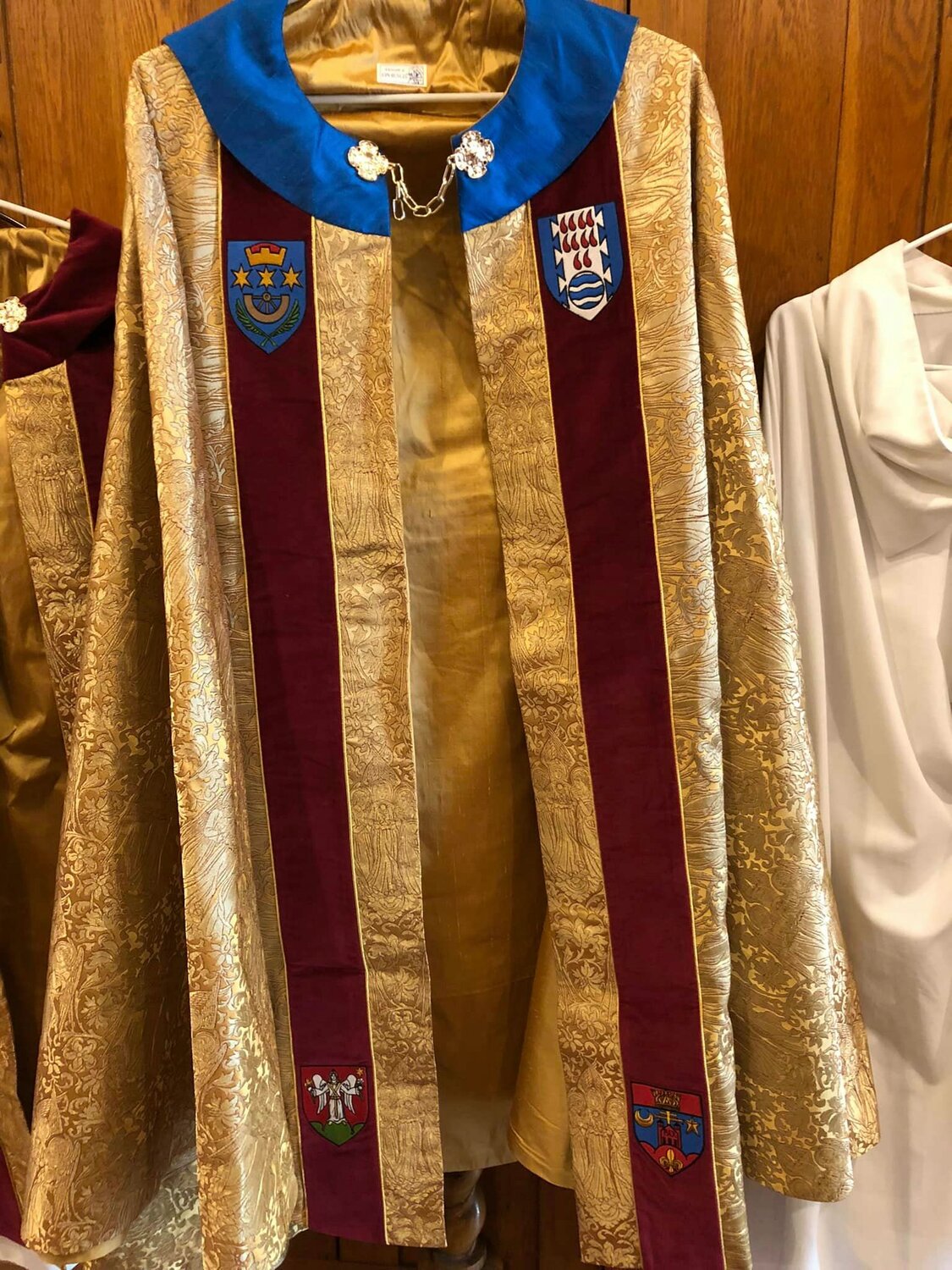Palmyra native monk designs vestments for abbey’s 150th

SCROLL THE ARROWS to see more photos.
People whose visual acuity and command of history surpass that of most others took particular delight in the new vestments created for Conception Abbey’s 150th anniversary.
Jubilee Masses were celebrated Dec. 8 and 11 in the Basilica of the Immaculate Conception, the center of the sprawling northwestern Missouri monastery where Benedictine monks have been forming seminarians and welcoming guests for 15 decades.
“It’s what kids refer to as an ‘Easter egg’ — something you might not notice right away but you’re happy when you do,” said Benedictine Father Pachomius Meade, a Palmyra native and artist who designed the vestments with several Benedictine of Mary, Queen of Apostles, sisters from the House of Ephesus in Gower.
Sisters in the Vestment Department there suggested incorporating a special damask fabric, adorned with a repeated pattern of three angels adoring Christ in the Eucharist.
“Our monastery’s motherhouse in Switzerland is in Engelberg, which means ‘Angel Mountain,’” Fr. Pachomius noted.
He took a sample of the fabric back to the monks who were planning the jubilee celebration.
“When they saw the angels and realized the significance, they said, ‘We obviously need to do that!’” the artist-monk noted.
Fr. Pachomius previously designed the current Coat of Arms for the Jefferson City diocese and created several traditional icons for his home church of St. Joseph in Palmyra.
He ministered for several years at Our Lady of Lourdes Parish in Columbia while studying at the University of Missouri.
He sketched the designs for the new vestments and drew the various Coats of Arms that were to be scanned and embroidered upon them.
He was the one who originally proposed having new vestments made for the jubilee celebration.
“We marked major anniversaries in the past with the commissioning of vestments,” he noted. “That’s one of the ways we’ve historically marked the passage of time here.”
The monks still use for major celebrations the vestments that were created for the abbey’s 100th anniversary a half-century ago.
Timelessly timely
The members of Conception’s jubilee committee encouraged Fr. Pachomius to draw up some sketches.
He proposed having vestments not just for Mass but also for Solemn Vespers, part of an ancient regimen of liturgical prayers prayed at times throughout the day.
His final sketches included three chasubles, which are ornate outer garments worn by priests during Mass; three copes, which are capes draped over the presider’s shoulders during Solemn Vespers and Benediction; and a matching dalmatic for a deacon to wear at Mass.
Fr. Pachomius noted that for liturgical purposes, the color gold can be substituted whenever white is called for.
He suggested using a gold-colored briquetted fabric set off with burgundy-colored orphreys, which are wide bands of contrasting cloth most often seen on the back of a chasuble.
One of Fr. Pachomius’s interests is heraldry, the ancient art of conveying history, identity and relationships through simple illustrations suitable for a banner or a shield.
“In order to show our lineage and heritage and relationships and ownership and mark the time, I wanted to incorporate some heraldic devices into the vestments,” he stated.
He rendered Conception Abbey’s Coat of Arms for the hood on the back of the abbot’s chasuble, and the basilica’s Coat of Arms and that of the motherhouse in Engelberg on the orphreys.
“To show our lineage and mark the time between our founding and now, I also wanted our founding Abbot Conrad’s Coat of Arms, and that of Abbot Neenan, our current abbot, on the other side,” Fr. Pachomius said.
These images are also used in various groupings on the other vestments.
The front of each includes a stylized version of an ancient image known as “Pax Inter Spinas” — which means “Peace Among Thorns.”
“It derives from a story from the life of St. Benedict, founder of the Benedictine order,” Fr. Pachomius noted. “The word ‘PAX,’ which means peace, is depicted as surrounded by a crown of thorns.”
Augmenting the abbey’s Coat of Arms on the abbot’s chasuble are three “fleurs de lis,” flowers that symbolize the Holy Trinity, and an eight-point Germanic-style star that resembles the rose window in a gothic cathedral. The center of the star is the monogram “M” for the Blessed Mother, patroness of the abbey.
Fr. Pachomius said the copes and chasubles were designed to have a main celebrant version with two assistants, “although any one of them could stand on its own at a liturgy.”
Stiches in time
After the committee and Abbot Neenan approved the designs, Fr. Pachomius and Benedictine Brother Maximilian Burkhart began collaborating with the Benedictine sisters who work in the vestment department in Gower.
The sisters agreed to assign priority to the project, in order for the handmade vestments to be finished before Dec. 8, the Solemnity of the Immaculate Conception, the abbey’s anniversary date.
The Jubilee Mass was the culmination of a yearlong sesquicentennial celebration.
Mother Abbess Cecilia of the Benedictines at Gower, and Sister Scholastica, head of the vestment department, “were both here for the celebration and got to see the fruit of their work being put to good use,” said Fr. Pachomius.
Beauty and truth
The artist-monk noted that living simply is part of Benedictine life.
But, so is creating beautiful things in order to draw the monks and their visitors into reverence and a deeper experience of prayer and worship.
He addressed the tendency among Catholics in the West over the past half-century to overemphasize words and thoughts in the Liturgy, often at the expense of other aspects of worship.
“More and more people are coming to an understanding that ‘I need a total experience of coming into prayer,’” he said.
He pointed out that the essence of the human person extends far beyond mere function.
“To have an encounter with God, people need to have their spirits raised,” he stated. “And it doesn’t just happen in words or in material ways.
“We need things that lift us out of our ordinary experience, to inform us that God is here and that this is actually happening,” he said.
“We don’t just find that in truth but also in beauty,” he noted. “It raises our eyes and attracts our attention.”
Fr. Pachomius referred to the “inexpressible groanings” of the Spirit that St. Paul writes about in his Letter to the Romans (8:26).
“These other things are part of how we encounter God in ways we cannot articulate — like visually and through music and through posture and through silence and in the spaces we inhabit,” he said.
“All of these things are important for bringing us into prayer. And we know that these things often do have a profound effect.”
For years to come
Fr. Pachomius called to mind a verse from “Asphodel, the Green Flower,” by American poet William Carlos Williams:
“It is difficult
to get the news from poems
yet men die miserably every day
for lack
of what is found there ...”
He pointed out that although perishable like everything else in this life, these new vestments will likely outlast every monk currently at Conception Abbey.
“I pray they’ll still be used by the monks who come after me and the many seminarians who come here to be formed in prayer and worship in the years to come,” he said.
Comments
Other items that may interest you
Services
The Catholic
Missourian
2207 W. Main St.
Jefferson City MO 65109-0914
(573) 635-9127
editor@diojeffcity.org


